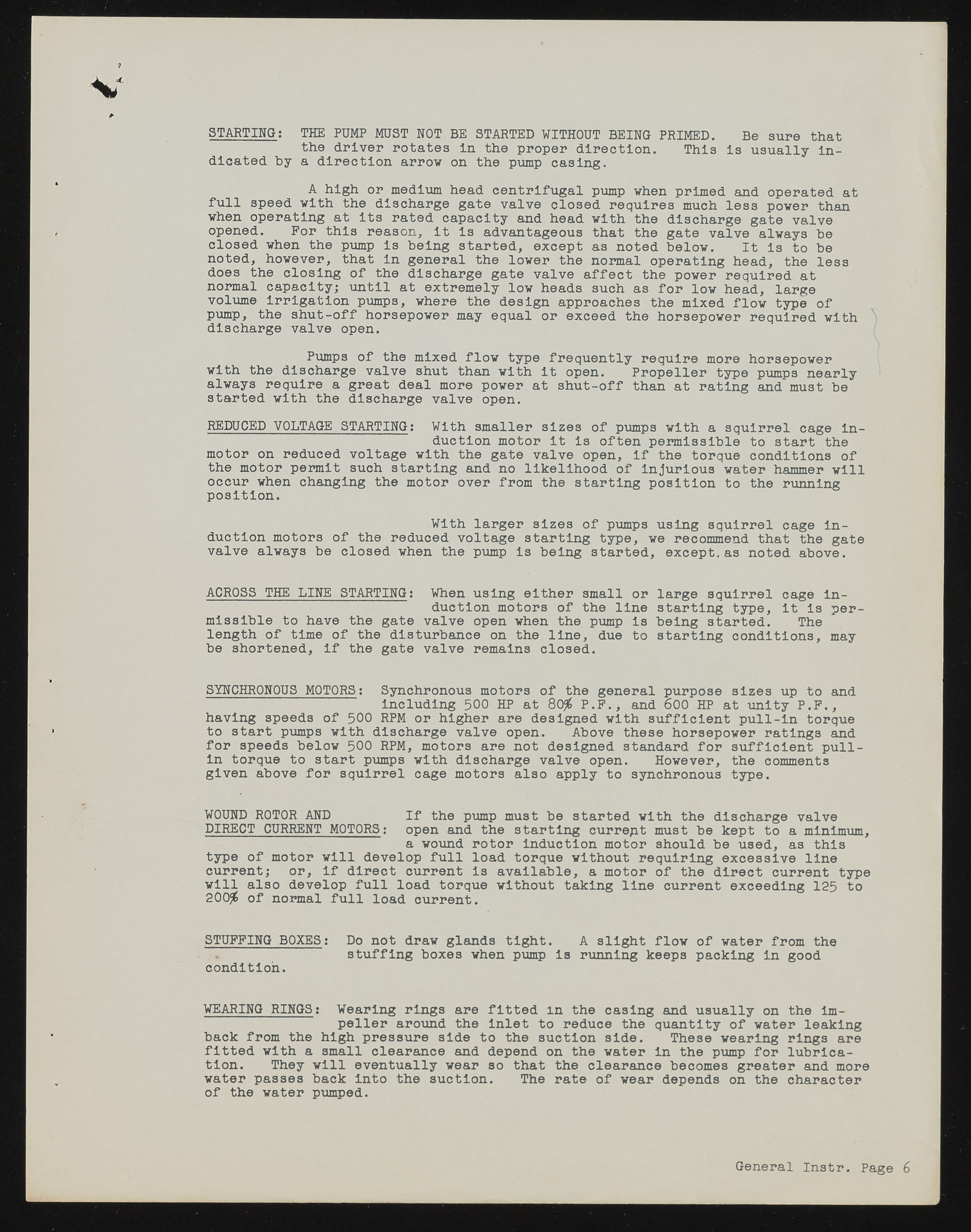Copyright & Fair-use Agreement
UNLV Special Collections provides copies of materials to facilitate private study, scholarship, or research. Material not in the public domain may be used according to fair use of copyrighted materials as defined by copyright law. Please cite us.
Please note that UNLV may not own the copyright to these materials and cannot provide permission to publish or distribute materials when UNLV is not the copyright holder. The user is solely responsible for determining the copyright status of materials and obtaining permission to use material from the copyright holder and for determining whether any permissions relating to any other rights are necessary for the intended use, and for obtaining all required permissions beyond that allowed by fair use.
Read more about our reproduction and use policy.
I agree.Information
Digital ID
Permalink
Details
More Info
Rights
Digital Provenance
Publisher
Transcription
STARTING: THE PUMP MUST NOT BE STARTED WITHOUT BEING PRIMED. Be sure that the driver rotates in the proper direction. This is usually indicated by a direction arrow on the pump casing. A high or medium head centrifugal pump when primed and operated at full speed with the discharge gate valve closed requires much less power than when operating at its rated capacity and head with the discharge gate valve opened. For this reason, it is advantageous that the gate valve always be closed when the pump i3 being started, except as noted below. It is to be noted, however, that in general the lower the normal operating head, the less does the closing of the discharge gate valve affect the power required at normal capacity; until at extremely low heads such as for low head, large volume irrigation pumps, where the design approaches the mixed flow type of pump, the shut-off horsepower may equal or exceed the horsepower required with discharge valve open. Pumps of the mixed flow type frequently require more horsepower with the discharge valve shut than with it open. Propeller type pumps nearly always require a great deal more power at shut-off than at rating and must be started with the discharge valve open. REDUCED VOLTAGE STARTING: With smaller sizes of pumps with a squirrel cage induction motor it is often permissible to start the motor on reduced voltage with the gate valve open, if the torque conditions of the motor permit such starting and no likelihood of injurious water hammer will occur when changing the motor over from the starting position to the running position. With larger sizes of pumps using squirrel cage induction motors of the reduced voltage starting type, we recommend that the gate valve always be closed when the pump is being started, except.as noted above. ACROSS THE LINE STARTING: When using either small or large squirrel cage induction motors of the line starting type, it is permissible to have the gate valve open when the pump is being started. The length of time of the disturbance on the line, due to starting conditions, may be shortened, if the gate valve remains closed. SYNCHRONOUS MOTORS: Synchronous motors of the general purpose sizes up to and including 500 HP at 80% P.F., and 600 HP at unity P.F., having speeds of 500 RPM or higher are designed with sufficient pull-in torque to start pumps with discharge valve open. Above these horsepower ratings and for speeds below 500 RPM, motors are not designed standard for sufficient pull-in torque to start pumps with discharge valve open. However, the comments given above for squirrel cage motors also apply to synchronous type. WOUND ROTOR AND If the pump must be started with the discharge valve DIRECT CURRENT MOTORS: open and the starting currejat must be kept to a minimum, a wound rotor induction motor should be used, as this type of motor will develop full load torque without requiring excessive line current; or, If direct current is available, a motor of the direct current type will also develop full load torque without taking line current exceeding 125 to 200^ of normal full load current. STUFFING BOXES: Do not draw glands tight. A slight flow of water from the stuffing boxes when pump is running keeps packing in good condition. WEARING RINGS: Wearing rings are fitted in the casing and usually on the impeller around the inlet to reduce the quantity of water leaking back from the high pressure side to the suction side. These wearing rings are fitted with a small clearance and depend on the water in the pump for lubrication. They will eventually wear so that the clearance becomes greater and more water passes back into the suction. The rate of wear depends on the character of the water pumped. General Instr. Page 6

